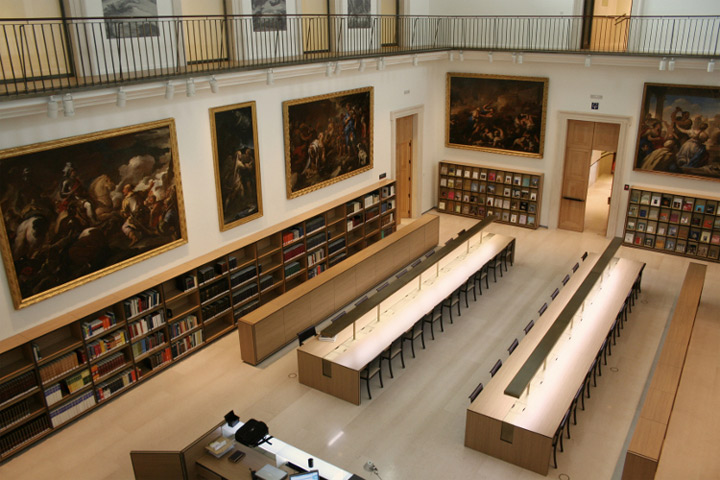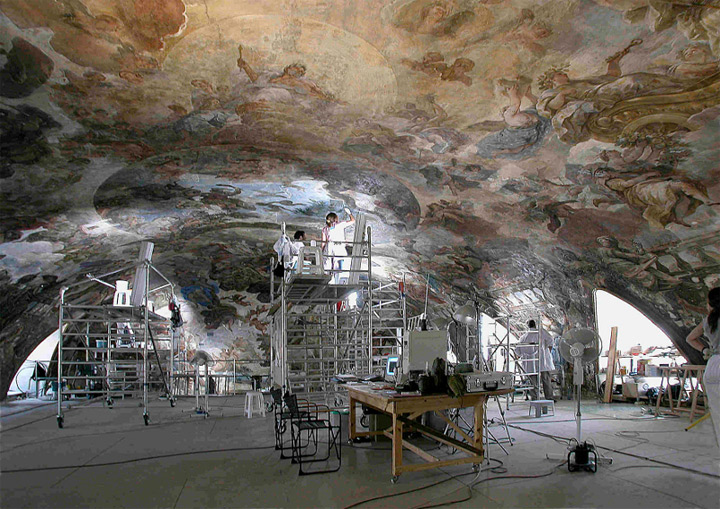Loading...
The Casón del Buen Retiro
The Casón formed part of the ensemble of buildings that comprised the Buen Retiro Palace, of which only the Casón and the Salón de Reinos now survive.
The Casón was designed by Alonso Carbonel, Chief Master of Works of the Buen Retiro Palace, who completed the plans by 1637 although the building was not finished until some years later. Inside, notable features include the paintings in the Salón de Baile (Ball Room) executed by Lucas Giordano around 1697. The building is completely disguised by the re-modelling undertaken in the last third of the 19th century, including the two monumental façades that were designed by the architects Mariano Carderera and Ricardo Velázquez Bosco.

Casón del Buen Retiro
Since the time it was built to house the Palace’s Salón de Baile, the Casón has been altered on numerous occasions and used for a wide variety of purposes, particularly over the last two centuries, as follows:
- Between 1834 and 1877 it was used among other purposes as the Cámara del Estamento de Próceres (the forerunner of the modern-day Senate or Upper House) , the Royal Topographical Cabinet, and as a gymnasium for Prince Alfonso. During the latter period, in 1868, the Crown’s possessions were seized and the City Council of Madrid took over the running of the Buen Retiro.
- From 1877 to 1960 the Casón housed the Museo de Reproducciones Artísticas, created on the initiative of the then President of the Government, Antonio Canovas del Castillo.
- In 1960, when that museum was moved to the Museo de América, the Casón was used as a temporary exhibition space by the State Office of Fine Arts until 1971. At that point it was handed over to the Museo del Prado for the display of its 19th-century collections which had formerly been in the Museo de Arte Moderno.
- From 1971 to 1981 the Prado exhibited its 19th-century paintings and sculptures in the Casón. In 1981 Picasso’s Guernica arrived in Spain and became part of the Museum’s collection, resulting in the need to dismantle the display on the main floor in order to install Picasso’s bequest in the Salón de Luca Giordano (the former Salón de Baile). The 19th-century collection was thus re-hung in the rest of the building, at times with difficulty due to the narrow dimensions of the rooms and the large size of the paintings.
- In 1992, Guernica was moved to the recently-established Museo Nacional Centro de Arte Reina Sofía. As a result, the 19th-century collection was re-displayed in the Casón. With the Royal Decree governing Collections of 1994, the Prado once more had to re-organise the display of these works in different rooms. This display remained in situ until 1997 when the building was closed for its most recent re-modelling and enlargement.
Library and study centre
Library
The Museo del Prado has one of the best and least known art libraries in Madrid. It specialises in painting and sculpture from the Middle Ages to the 19th century and also has important holdings of books on drawings, prints, classical sculpture and the decorative arts. The Library has 70,000 books, 1,000 periodical titles, as well as audiovisual works and manuscripts. It is particularly rich in foreign publications including exhibition catalogues, museum catalogues, monographs on artists etc, many of them hard to find in other Spanish libraries. The Library also has an important collection of auction catalogues.

Library. Casón del Buen Retiro
The Museum makes considerable investments in the acquisition of new titles for the Library. The most significant additions are two important private libraries. This first is that of José María Cervelló (born Cadiz 1947) comprising around 10,000 volumes including a remarkable collection of classical treatises on art and architecture. The second is the library of the Daza-Madrazo family, consisting of around 1,000 books largely from the magnificent library of José de Madrazo (1781-1859), Painter to Ferdinand VII and Director of the Museo del Prado from 1838 to 1851. In addition, the Museum acquired by donation the library of the collector Antonio Correa consisting of 1,500 volumes and an interesting group of illustrated periodicals and books on Modernism.
The Library occupies various floors in the Casón. Having entered via the vestibule on calle Alfonso XII, the user finds the Reading Room and the open access reference library that occupies the former Salón de Baile with the ceiling painting by Luca Giordano. This floor also houses the user services rooms (information, facilities for making copies, computer terminals for consulting the catalogue etc) and internal offices. The book stores are located on Floors 0 and -1. These stores have been equipped with optimum environmental and security measures.
The Library is open to all those who need to use its holdings, with the only restriction being their correct conservation. Nonetheless, and due to its particular nature, the Library is primarily oriented towards researchers, firstly the technical staff of the Museum and future students of the Studies Center. The library offers consultation facilities in the Reading Room, bibliographical information, and access to its electronic and copying facilities. Given that it is a specialist library, books are not loaned out although there is an inter-library loan service.
The Study Centre
The Action Plan approved in October 2004 envisaged the creation of a Study Centre and its installation in the Casón del Buen Retiro, within the proposed Prado Campus.
The re-modelling of the Casón allows for the Curatorial Departments, the Archive, Library and the Documentary holdings to be housed together. In addition, the Casón also houses the Academic Chair of the Museo del Prado, which aims to be an international institution of the highest level. This project enables the Museum to fully implement its educational aims and aspirations, which have been present since its foundation.
The Academic Chair of the Museo del Prado
The Museum’s strength lies in its artistic and historical collections and its team of professionals, and together these elements constitute the pillars of the Academic Chair of the Museo del Prado, which bring together various initiatives focused on its dual mission of training and research. The first, which is aimed at specialist students, result in an increase in Museological studies, covering Restoration, Curatorship and Collection Management, as well as offer further studies for graduate students and high level training for professionals. The starting point for all these activities is the establishment of a grant programme for its first students.
With regard to the second aspect, that of research, the Academic Chair counts on the participation in the life of the Museum of Spanish and international scholars through collaborative programmes with other institutions and research fellowships, making the Centre’s facilities available for them to undertake research.
The activities of the Museum’s Curatorial departments and the programmes of the Academic Chair of the Museo Nacional del Prado occupy two floors of the Casón (Floors 1 and 2).
The Casón in the Prado Campus
On 20 October 2004, at a plenary session of the Royal Board of Trustees of the Museo del Prado, the Action Plan 2005-2008 was approved. The text of this Plan proposed concentrating the Museum’s Permanent Collection in the Villanueva-Jerónimos complex, integrating the display of the 19th-century collections into the historical collection for the first time. In addition, and as a key element in the so-called Prado Campus project, the Plan approved the creation of a Study Centre for the Museum which would be housed in the Casón del Buen Retiro.
In line with the concept approved in the Action Plan and following its inauguration in 2008, the Casón will be used in the following manner:
- Basement Level 1: Internal installations and services
- Ground Floor: Library, Archive and Documentary Centre
- Principal Floor: Reading Room of the Library
- Floor 1: Board Room, Curatorial Departments and the Studies Center
- Floor 2: Curatorial Departments
Restoration work on the Casón was completed in October 2007.
The re-modelling and enlargement
The project to re-model and enlarge the Casón del Buen Retiro was supervised by the Infrastructure Management Department of the Spanish Ministry of Culture. The design and construction of the project were awarded to UTE NECSO-FCC in 1988 under the direction of the architects Jaime Tarruel (for the UTE) and Manuel Martín Rabadán (for the Infrastructure Management Department).
The project consisted of excavating two new floors and consolidating the entire structure of the building, which was discovered to be extremely unstable at the outset of the project. This delicate and laborious process benefited from the technical support of the CEDEX. Almost the entire structure of the building was lined with new cement walls, guaranteeing its stability and allowing for the excavation of two new floors through the use of a system of micro-piles.
The addition of these two new floors resulted in a further 3,157 square metres of floor space, almost doubling the pre-existing surface area. The Casón has a total surface area of 8,233.65 square metres.
During the process of re-modelling, the ceiling with Luca Giordano’s painting was stabilised and restored by the AGORA restoration team, supervised by technicians from the Museo del Prado and the Instituto de Patrimonio Histórico.

The ceiling of the Casón during its restoration.
The Allegory of the Golden Fleece by Giordano
The ceiling of the Casón was painted by Luca Giordano (1634-1705), a Neapolitan artist known in Spain as Lucas Jordán. In 1692 the artist was summoned by Charles II to decorate the staircase and vaults of the Basilica of El Escorial (1692-1694). He then embarked on the decoration (now lost) of the office and bedroom of the king in the Palace of Aranjuez; the Casón del Buen Retiro (ca.1697); the Sacristy of Toledo Cathedral (1698); the Royal Chapel of the Alcázar (destroyed); and San Antonio de los Portugueses in Madrid (1699). The ascent to the throne of Philip V in 1701 and the start of the War of Spanish Succession resulted in the artist’s return to Naples in 1702. He died there in 1705, leaving behind an extremely large oeuvre and a considerable fortune.
The subject depicted on the ceiling of the Casón is The Allegory of the Golden Fleece in the form of an homage to the Spanish monarchy executed during the reign of the last Spanish Habsburg monarch. The composition commemorates the foundation of the Order of the Golden Fleece, established by the Dukes of Burgundy and brought to Spain by Charles I who belonged to that ducal house. In Giordano’s composition a large number of allegorical figures referring to the political power of the monarchy are grouped around a celestial sphere with the signs of the Zodiac. From it hangs the decoration of the royal Order in the form of a golden chain with a lamb.
The artistic importance of Giordano’s ceiling, which is one of the masterpieces in the Prado’s collection, seems to explain why the Casón survived whereas most of the other buildings in the Buen Retiro complex disappeared with the construction of the Jerónimos area. The restoration of the painting, undertaken as part of the re-modelling of the building, involved the consolidation of the fresco’s original paint, of which around 80% survives.
The restoration of this room was undertaken with the aim of placing the greatest possible emphasis on the ceiling, reinstalling the interior balcony which originally ran round the room and equipping it with a new lighting system.
